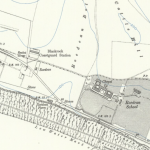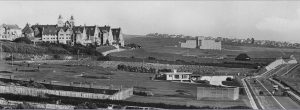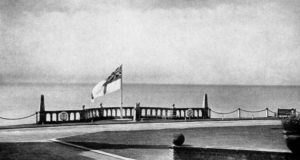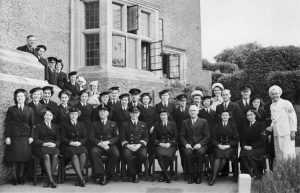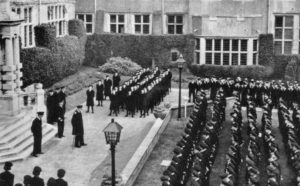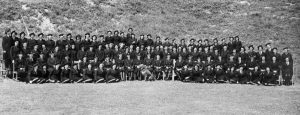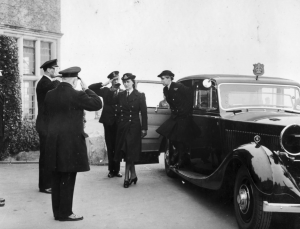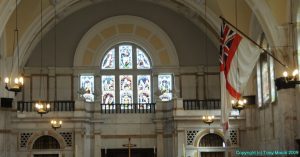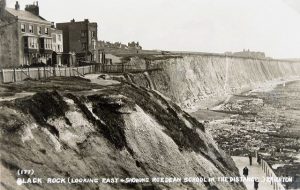
Black Rock – early 1900’s
Roedean was the name given to a gap in the cliffs between Brighton’s town boundary at Black Rock and the Ovingdean Gap in the parish of Rottingdean and records of the name date back to at least 1724. It was the site of a tollgate on the Newhaven turnpike, and there was a windmill at Roedean from around 1750 to about 1790, In the early 19th century two farms established in the area, Black Rock Farm near the present day Marine Gate and Roedean Farm, with its farm house standing to the south of the old coast road between Brighton and Rottingdean, almost opposite the entrance to Roedean School.
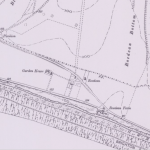
OS Map from 1850sOther than the two farms the first big development in the area was the gas-works to the west of the cliff at Black Rock, established in 1818-19 by the Brighton Gas Light and Coke Company. Then over the next fifty years and certainly by 1870 a coastguard station had been built east of Black Rock Farm house and a large country property called Garden House was built on the site of the current Roedean pitch and Putt. There were also a number of coastguard cottages on the cliff edge between the two farms.
Other than the two farms the first big development in the area was the gas-works to the west of the cliff at Black Rock, established in 1818-19 by the Brighton Gas Light and Coke Company. Then over the next fifty years and certainly by 1870 a coastguard station had been built east of Black Rock Farm house and a large country property called Garden House was built on the site of the current Roedean pitch and Putt. There were also a number of coastguard cottages on the cliff edge between the two farms.
In 1893 the East Brighton Golf Course was founded on its present site, known then as Kemptown Golf Club and a large house with substantial grounds was built to the east of the existing club house called Downside, now the site of the houses of Roedean Heights.
By 1897 the old coast road was closed when cliffs collapsed at Black Rock, taking with it some of the old coastguard cottages. In its place a new road was constructed which follows the course of todays Roedean Road. Then in 1898, Roedean school was built on its present site, designed by the architect Sir John Simpson and in 1900 a row of coastguard cottages were built to replace those lost to the cliff collapse three years earlier and these still stand and today form Roedean Terrace. White Lodge-on-The Cliff, originally designed and built again by Simpson was finished in 1904, however it was remodelled and extended by it’s second owner, Lady Sackville to a design by Edwin Lutyens in 1923. And in the intervening twenty years several more houses were built on the Cliff and one at the entrance to Roedean Crescent.
The miniature golf course was closed during WW2 and became the site of a Royal Canadian anti aircraft artillery position, re-opening again soon after the end of the war. OIn 8 August 1936 Black Rock swimming pool was formally opened with a pool, 165 feet by 60 feet, and handsome changing rooms and cafe. Above this site, 1939 saw the opening of Marine Gate, a large eight-storey block of 105 flats designed by Maurice Bloom round an open quadrangle. Originally there was a large public restaurant until it was converted for further residential accommodation in about 1955, but the block’s proximity to the gas-works resulted in a good deal of bombing during the war and it received a direct hit in 1944.
In the early spring of 1941 Roedean School for Girls, Brighton was selected by the Admiralty to become home to H.M.S. VERNON, the Royal Navy’s torpedo, mining and electrical training establishment. The advance party, under command of Lieutenant J. R. Carr, arrived at Roedean on April 7th 1941.
It has passed into naval lore that before the navy moved into the school the Captain insisted that all of the female pupils should leave; it was rumoured that some of the sixth formers were still in residence. The mistress in charge, reportedly replied “my girls will be all right; they’ve got it up here” tapping her head” to which the Captain answered “Madam, it matters not where your girls have it, rest assured my sailors will find it!”
The main building at Roedean School has its main entrance facing the south, with four north/south oriented ‘Houses’ these being numbered 1 – 4; viewed from the cliff top house numbers run left to right. In front of the main entrance is an open area referred to as the quadrangle, at its south edge is a stone balustrade offering an uninterrupted view across the grounds and along the coast road to Brighton and Rottingdean. The area of the balustrade was referred to by the navy as the ‘Quarterdeck’, a revered area within a shore establishment, the site of the flagstaff flying the Naval Ensign – the Quarterdeck must be saluted by naval personnel when passing as a mark of respect.
The School’s quadrangle doubled as a parade ground, the site of Sunday divisions (parade of ship’s company before church) at which the men and women of HMS VERNON would be addressed by the Captain and inspected.
Before the end of the first year, more space was needed, both for accommodation and instruction; few rooms at Roedean were large enough to hold lectures for 200 men with the exception of the main hall, the gym, and at first the art school which later became part of the Wardroom. Suitable premises were found by requisitioning St Dunstan’s Home for the Blind at Ovingdean. This new building had opened in October 1938, but like the Girl’s School a quarter mile down the road, the organisation had been evacuated to Church Stratton, Shropshire in 1940. This site was used for several purposes, including an electrical instruction ‘school’, HMS VERNON’s central pay office, sub-lieutenants’ sleeping quarters and the ratings canteen and bar.
Many ratings arriving at Roedean School thought the place looked gothic and creepy, as they looked up at the imposing buildings from the sentry post at the gates. Large proportions of these men were fresh out of basic training and were still wet behind the ears, while seasoned hands found Roedean a big change. The navy still used hammocks, both at sea and in many cases ashore, slung in large communal spaces, each man carried his own hammock from ship to ship as a part of his personal kit. The small rooms (three men to a room) and single ‘cabins’, all with bunks that formed the accommodation at Roedean were an unheard of luxury.
The Wardroom staff at HMS VERNON (Roedean School), the Officers Stewards and Cooks and general domestic staff. C. 1943
Mr. Nick Lade. Navy Research
Besides the Naval personnel of HMS VERNON there was a large number of civilian staff, some were hired locally to fill domestic positions, others such as Draughtsmen moved from Portsmouth with the establishment and lodged in the local area. In Portsmouth many of these men had been a part of their local Home Guard unit and they were eagerly welcomed into the ranks of the Rottingdean Home Guard by their Commanding Officer Colonel Percy Filkins, M.C., a local farmer from Ovingdean. Ratings from VERNON helped out on Colonel Filkins’ farm on occasion, including harvest time.
The Captain addresses the men & women of VERNON (Roedean) during divisions.
Photo: Lt Cdr Rob Hoole RN, Navy Research
It is rumoured that the first batch of trainees to be billeted at Roedean received a rude awakening after eagerly pressing a small button found above every student’s bed – a small label carried the legend ‘Press if you need a mistress for any reason during the night’. After the bell at the other end had been rung to near destruction and the members of the duty watch had been driven mad, the only person to arrive in response to their requests was an irate Chief Petty Officer promising unmentionable consequences for touching the button ever again! The buttons were subsequently disconnected!
Officers attending VERNON for courses could be billeted ‘ashore’ in Brighton, Rottingdean or other local villages, some married men brought their wives down to join them.
Games and organised sports helped VERNON (R) to keep a good liaison with the neighbouring naval establishments – HMS King Alfred at Hove and Lancing and HMS Marlborough at Eastbourne College, the Canadian and British Army units stationed around Brighton, and the National Fire Service School at Rottingdean. Hockey, cricket and tennis, saw the games fields at Roedean put to good use. Several officers took in part in hockey matches, with the Wrens fielding a team which gave them some good matches. It is not clear whether there was a VERNON (R) football team but he ratings did ‘knock about a football’ in their brief spells of spare time, usually between finishing meals and mustering to march off for instruction. Often some of the local girls who worked at VERNON joined in the kick about; 93 year old Miss Laurie Hollands of Ovingdean recalls how they would rush to finish their duties in time to join in with the lads. Roedean School also had a swimming pool which went some way to making up for the beach being off limits, being both wired and mined!
A number of those who served at HMS VERNON were locals, young women recruited to fill posts in the various sites as ‘immobile Wrens’ – enlisted into the WRNS but for service only in a specified area around their home. These Wrens wore the same uniform as regular WRNS and had the same duties and responsibilities but they lived at home and could not be drafted outside their home area. Jobs filled by ‘immobile’ Wrens included cooks, stewards, typists and store clerks. Wren Steward Lois Lade (nee Price) was one such ‘immobile wren’ she enlisted in November 1941 for work in the Brighton area and was allocated to HMS VERNON the following month for duties as a Wardroom Steward. She cycled the 2 miles from her home in Mayo Road to Roedean every day. In 1945 she was promoted to Leading Wren Steward (O) and married Rifleman Christopher Lade of the Royal Sussex Regiment on VJ Day.
The WRNS personnel of HMS VERNON (R)) – 91 ratings, 14 SNCOs, and 8 Officers. C. summer of 1945 Photo: Nick Wade, Navy Research
Instruction was given Monday to Friday and Saturday mornings, involving marching six or seven hundred men into the workshops in and around Brighton twice a day for instruction and back, some as far away as the Dreadnought Garage site in Hove. The daily routine was quite intensive, consisting of – breakfast, classes, lunch, classes, tea, classes, and dinner. There was little free time other than Saturday afternoon and Sunday. After Sunday Divisions some of the men would to go to Neville House, a family hotel at Black Rock (164 -165 Marine Parade Brighton) for tea, biscuits and a read of the Sunday papers. Other popular off duty pastimes in Brighton included ice skating, attending the Hippodrome theatre, and dances at the Dome or at the Regent Ballroom.
In March 1944 the establishment received a Royal visitor when Princess Marina, the Duchess of Kent came to inspect the Wrens and stayed to lunch at John Howard House. Miss Tanner, the Headmistress of Roedean School, was a frequent visitor to HMS VERNON (R), for ‘tours of inspection’; she took the threats of the RN returning to visit after the war – to see if the place was as clean as a girls’ school as it was as a naval establishment – in her stride. She was a popular guest, so much so that on September 6th 1944 she was invited to take the salute at the weekly march past of divisions, Miss Tanner carried it off with great distinction.
Captain H. E. Morse, RN DSO greets HRH Princess Marina of Greece, Duchess of Kent, on her arrival at Roedean in March 1944. She was attending in her capacity as Chief Commandant of the W.R.N.S to inspect the Wrens. Photo: courtesy Mr. Nick Lade, Navy Research
There were two marriages held at Roedean during the naval occupation. Electrical Artificer Jack Parsons and Leading Torpedoman Felix McClusky marrying Wrens that they had met while attending courses at VERNON (R); Felix married Dorothy in 1942 while Jack married Violet in 1943.
HMS VERNON (R) made for an easy target for enemy aircraft and its proximity to the beach gave cause for concern; armed sentries patrolled the perimeter of the site day and night, whilst the duty watch manned sentry posts at entrances. The various instructional sites in the town also had sentries posted, a duty which fell to junior rates at the establishment – at least once during their time there, trainees being utilised as security manpower when not under instruction. The threats of attack from a U-Boat landing party was taken seriously, and regular exercises were held against this eventuality- luckily none ever materialised. During early 1944 the Army Divisional Commander, Lieutenant General Montgomery, visited HMS Vern on to advice on the defences; he had a few words for the VERNON civilians who he had encountered when they were on Home Guard sentry duty.
There were few instances of enemy action affecting HMS VERNON with the exception of ‘tip and run’ aircraft attacks, machinegun rounds and cannon shells caused some casualties. One rating was killed whilst he sat in the canteen at St. Dustan’s, hit be a single stray bullet from a machinegun, another was injured when he was hit in the knee by a cannon shell, this chap was lucky, the shell failed to detonate, he recovered in hospital. Bomb damage to Marine Gate saw two fatalities, a Sub-Lieutenant, and an officer’s wife were killed in one of many raids which damaged the block of flats; the building was eventually deemed unsafe later in the war and evacuated until repairs could be made.
May 25th 1943 – Brighton’s worst Air Raid
One of the VERNON (R) civilian Draughtsmen went missing early on the afternoon of May 25th 1943, he had been walking on the cliff after lunch but was never seen again; this was the day of a major air raid on Brighton and it was feared that the man was hit by enemy fire and fell into the sea. At just after noon, Captain Egerton, who was due to be relieved by Captain Harold Morse, RN DSO on June 4th, was on the Quarterdeck along with the ship’s officers gathering for a group photograph to mark his leaving. While the assembled officers were being lined up for the shot the air-raid siren went of. No one took any notice until they saw about a dozen planes flying due west, below the level of the cliff at wave top height, heading towards Brighton. The group scattered as another dozen aircraft which had approached the back of the school over the downs roared over them; these were so low that the colour of the bombs in the racks could be clearly seen. There were a few cannon shell fired as they sped past but no casualties were incurred at Roedean.
Victory in Europe – HMS VERNON returns to Portsmouth
May 8th 1945 marked the end of the war in Europe and both Roedean School and HMS VERNON turned their attention to returning to normality. The need for dispersed military bases and schools and children evacuated from the densely populated areas of war-time Britain had come to an end; June 7th 1945, was the last day of naval instruction at Roedean.
The White Ensign still proudly hangs in the school chapel, the Ensign was presented to the Headmistress when the Admiralty returned the buildings to the control of the school,
Photo: Courtesy of Tony Mould, My Brighton Community
HMS VERNON began the move back to Portsmouth the next day; the operation involved ninety-two 5 ton lorry loads and was completed in just over a month. By mid July the various sites occupied around Brighton and Sussex were being cleaned up and prepared for return to heir civilian owners. Roedean was reopened as a girls’ school in January 1946.
The current Roedean neighbourhood itself began to develop with houses built on the western parts of Roedean Way and Roedean Crescent as far as Roedean Path, during the 1930’s and early 1950’s. The eastern portion up to Roedean Vale was completed by the end of the 1960’s and today Roedean and the Cliff has a population of over 600.
We have tried to ensure this history page is as accurate as possible but if you have any updates or corrections please let us know. And if you have any old photos or maps you’d like us to add to this page, please get in touch via the contact form.
You may also be interested in visiting www.streetcheck.co.uk/postcode/bn25rh for more information about your street.
